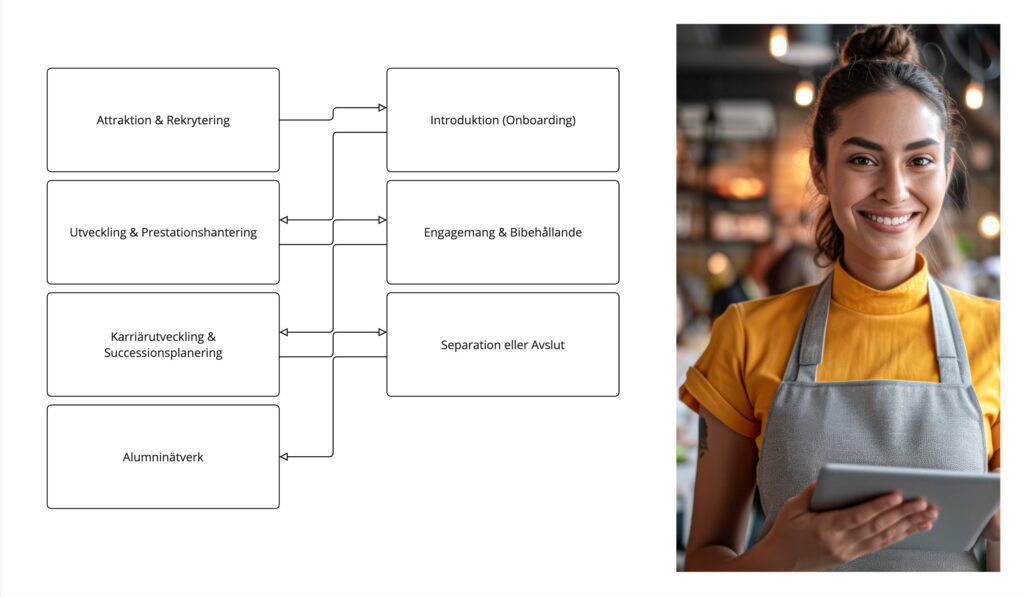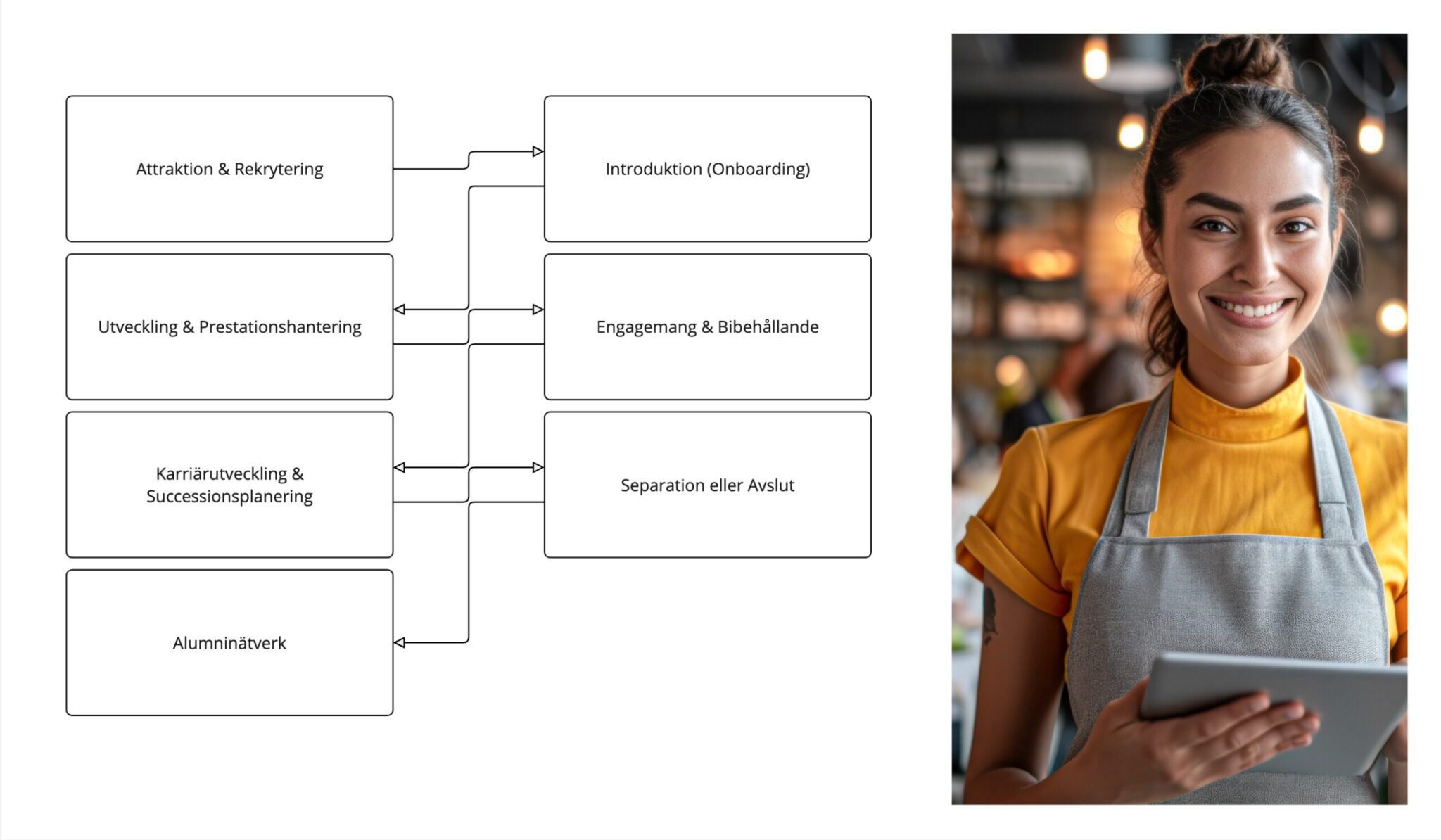Introduction: Building a successful employee journey within the hospitality industry

In the hotel industry, where every guest experience is crucial, employees are the heart of the business. Attracting, developing and retaining talented employees is critical to providing exceptional service, which in turn drives hotel success and guest satisfaction. This process is designed to support the entire employee journey – from the first encounter with the hotel brand during recruitment, to their career development and finally when they leave the organization.
This holistic approach helps hotels not only attract the right talent, but also foster a culture of continuous learning and high motivation. By offering clear career paths, fair reward and recognition, and a healthy work-life balance, hotels can create a work environment where employees thrive and perform at their peak.
Below is a detailed description of each phase of the employee journey, adapted specifically for the hotel industry. Each step is designed to ensure that hotel employees not only reach their full potential, but also contribute to outstanding guest experiences and the hotel's long-term success.
1. Attraction & Recruitment
• Job marketing: Create attractive job ads that highlight the hotel's brand and benefits (eg discounts, training, career opportunities) to attract talent. Use pictures and descriptions of the hotel to show the work environment.
• Candidate search: Use hotel specific platforms, job sites for service professions, social media and internal employee recommendations. It is particularly important to have a close collaboration with educational institutes that offer hotel training.
• Interviews & Selection: Evaluate resumes focusing on service experience, customer orientation and problem solving skills. Conduct interviews that emphasize the candidate's guest service skills and ability to handle stressful situations.
• Time frame: For service and reception roles, the process can be quick (1-3 weeks), while management roles can take longer depending on market competition and demands.
2. Introduction (Onboarding)
• Training & Introduction: Introduce new employees to the hotel's procedures, systems (booking system, check-in/check-out), and fire safety. Make sure they understand the company's values around hospitality and service.
• Expectation management: Clarify their specific role, responsibilities and goals, such as maintaining high guest satisfaction and responding to inquiries promptly.
• Mentorship & Support: Assign an experienced colleague or head of department as a mentor during the first few weeks, especially to help them feel comfortable with routines and standards.
• ServiceHub: To streamline onboarding and digital training, the hotel can use ServiceHub, an app from the School of Service. Through ServiceHub, new employees can quickly and smoothly enter the work with access to online courses and instructions that are tailored to the hotel industry.
• When does it start?: Onboarding begins immediately after the candidate accepts the position and includes a more intensive period during the first 1-2 months.
3. Development & Performance Management
• Continuous learning: Give employees access to courses in service and additional sales. The hotel can also organize training in hospitality and cultural understanding for international guests.
• Goal setting: Hold regular conversations about performance and goals, such as increasing guest reviews and improving customer satisfaction in surveys.
• Performance appraisal: Conducts quarterly performance reviews based on feedback from guests and colleagues.
• Coaching & Mentoring: Offer coaching from managers and ongoing guidance to improve specific skills, such as how to handle complaints or improve upselling.
• School of Service: To promote continuous development, the hotel can benefit from training and courses offered via School of Service, which are designed to elevate employees' service quality and leadership.
• Time frame: This process is ongoing throughout the employment period, with a focus on following up goals and development plans at least every quarter.
4. Engagement & Retention (Retention)
• Balance between work and private life: Offer flexible working hours and scheduling that enable employees to have a better work-life balance, especially during intense periods such as high season.
• Recognition & Rewards: Implement a recognition system where employees are rewarded for high guest satisfaction, additional sales or creative solutions to guests' problems. Examples could be "Employee of the Month", bonuses or internal competitions.
• Well-being for employees: Provide wellness programs, gym memberships or other benefits to promote both physical and mental health. It can also be about offering free breakfast/lunch for those who work long shifts.
• Feedback from employees: Conduct regular conversations with staff to gather feedback on the work environment, and be proactive in improving what isn't working.
• Time frame: This is an ongoing process, but it is especially important to reinforce these efforts after the first six months.
5. Career development & succession planning
• Career paths: Develop career paths for all levels of the hotel, from reception to management roles. Provide clear opportunities for advancement, for example going from receptionist to front office manager.
• Leadership development: Offer leadership training to those who show potential to take on greater responsibilities, especially those who may become future department heads.
• Succession planning: Identify key people for compensation plans, especially in management and key roles that require specific skills (eg event coordinators or booking managers).
• Time frame: Usually begins after the first year and continues depending on performance and the needs of the organization.
6. Separation or Termination
• Exit Interviews: Conduct exit interviews to understand why employees leave, and identify any areas for improvement within the work environment.
• Termination (Offboarding): Ensure all practical aspects of termination are handled effectively, including return of uniforms, termination of employment contracts and handover of duties.
• Time frame: This phase takes place in the last few weeks after an employee has announced their resignation or been dismissed.
7. Alumni Network
• Networking capabilities: Stay in touch with former employees through networking and hotel events. This can help maintain a good relationship and open up to future opportunities.
• Reemployment: Offer openings for former employees who enjoyed themselves but perhaps left for personal reasons, through alumni events or through direct contact.
• Time frame: The post-employment phase occurs after the employment has ended, often through regular updates or events.

